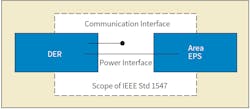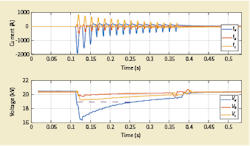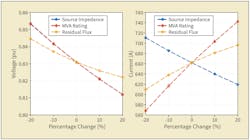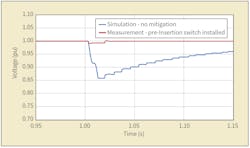When DER Installations Require Mitigation to Meet Interconnect Standards
Today’s utilities are striving to reduce their carbon footprint by installing clean and sustainable technologies, such as wind and solar generation. As the penetration of renewables in the grid increases, utilities face emerging challenges. Voltage sags from energizing renewable generation transformers is one of the power quality issues that could negatively affect customers, interrupt load equipment and incur significant expense to resolve. Due diligence and proper inrush mitigation are necessary to avoid or resolve the voltage sag issue.
Distributed Energy Resources (DERs), such as solar farms and battery energy storage systems (BESS), are becoming increasingly integrated within electric power systems (EPS). As a result, minimizing the inrush currents—including harmonic components and the resulting system voltage drop that occurs during energization of DER transformers—is becoming extremely important. It is common for a DER facility to be located on a weak, medium-voltage distribution system (≤ 38 kV). As the penetration of renewables increases, traditional generation that provides short-circuit strength diminishes.
When connecting DERs to the local grid, the voltage at the point of interconnection is subject to rapid voltage change (RVC). RVC is caused by the inrush currents resulting from energization of the DER transformers and may lead to disruption of operations at nearby industrial and commercial businesses. As requests for permitting DERs continued to grow, Dominion Energy Inc. decided it was important to study existing installations and determine how well they complied with industry standards, such as those developed and agreed to for DER interconnection. Operational problems observed with new installations and some existing applications highlighted the need for additional investigation.
An electricity and natural gas supplier to customers in 20 U.S. states, Dominion Energy has heavily invested in renewable energy and plans to expand its offshore wind, solar and energy storage to 24 GW in the next 15 years in Virginia alone.
Industry Standards
It is critical that existing and new DER installations meet the latest industry interconnection requirements and ensure all requirements are satisfied. Collection and monitoring of the operational data from DERs are considered essential to predict future behaviors.
IEEE Std 1547-2003 Standard for Interconnection and Interoperability of Distributed Energy Resources with Associated Power System Interfaces was the first in a series of standards developed concerning distributed resource interconnections. Traditionally, utility systems were never designed to host active generation and storage at such high penetration levels. The intent of the standard was to define the technologies and operational concepts to integrate DERs effectively into existing grids in a manner that can be universally adopted and relevant across a number of industries. The Standards Coordinating Committee 21 on Fuel Cells, Photovoltaics, Dispersed Generation, and Energy Storage continued to work on the standard. The committee issued and published an update to the standard in 2018 (IEEE Std 1547-2018).
Section 7.2.2 of the standard states, “When the interconnection is at medium voltage, the DER shall not cause step or ramp changes in the rms voltage at the PCC exceeding 3% of nominal and exceeding 3% per second averaged over a period of one second.”
Annex G.2 of standard IEEE Std 1453-2015 Recommended Practices for the Analysis of Fluctuating Installations on Power Systems defines RVC as the fundamental frequency rms voltage over several cycles. IEEE Std 1453 establishes planning levels for RVC changes based on the number of changes as shown in the table above right. The stricter 3% limit, selected in section 7.2.2, was adopted to allow additional system capacity for other fluctuating installations, such as customers’ or additional DER installations.
The Challenge: Gathering the Real Data
Obtaining real-time data in true field conditions generally is challenging. Dominion Energy has data recorders throughout its system, which enabled a comprehensive analysis of the RVC events during energization of DER transformers.
A majority of Dominion Energy’s DERs are sourced from utility-scale solar plants connected to 34.5 kV. This voltage level provides hosting capacity as high as 20 MW. In a simplified interconnection, the DER interfaces with the distribution feeder through a PCC recloser that is remotely monitored and controlled by system operators. Through manual or automatic reclosing, the DER transformer can be energized. Transient current and voltage are recorded at the PCC by protective relays for post-event analysis. The sampling rate is 128 data points per cycle.
A statistical study by Dominion Energy evaluated more than 700 test energization events from 69 solar power plants. Among the switching events, 77% exhibited voltage drops of greater than 5%. The voltage dipped to 0.89 per unit (pu) on average with a sag duration of 5.9 cycles. The lowest voltage reached 0.70 pu and the longest duration was 24.9 cycles. Given the values of retained voltage and sag duration, these could have had an adverse impact on load equipment had mitigation measures not been taken.
Problem Diagnosis
Transformer cores carry alternating magnetic flux during steady-state operation. Depending on the timing of transformer disconnection, a certain amount of magnetic flux remains. Upon reenergization, momentary inrush current and voltage sag can be observed. An example of a test energization event is shown on the next page. The worst inrush occurs on the phase where residual flux is highest, as the switch-in phase voltage is at zero crossing and changes in the same direction of the residual flux buildup. Given the arbitrary nature of transformer disconnection and switch-in times, the severity of voltage sag varies even at the same DER facility.
For example, Dominion Energy studied a case where one of the phases showed a high inrush because of the significant residual flux, with the energization point of voltage zero, driving the transformer core into saturation. Frequency spectrum analysis on the current measurement revealed the presence of second, third, fourth and fifth current harmonics. Such harmonic components could excite resonance on the circuit and negatively impact customers.
All three phases experienced a momentary voltage sag. The lowest value of root-mean-square (rms) voltage is defined as retained voltage by IEEE Std 1564 Guide for Voltage Sag Indices. The duration is defined as the length of the interval between the time the rms voltage drops below and subsequently rises above a given voltage threshold. As noted previously, IEEE Std 1453 and 1547-2018 establish planning limit ranges from 2.5% to 6% of the nominal and the range is determined by system voltage level and frequency of occurrence. For purposes of Dominion Energy’s investigation, it selected 5% as the threshold. In other words, voltage dropping below 0.95 pu would be considered a violation.
Modeling & Field Data Observations
The worst voltage sags tend to take place at large DER facilities (usually more than 15 MW) connected to weak systems that are typically 2 miles (3.2 km) or more from utility substations. Electromagnetic transient program (EMTP) studies were made with simulation models that had a topology similar to that of the Dominion Energy case described previously, where one of the phases showed a high inrush because of the significant residual flux and, ultimately, resulted in all three phases experiencing a momentary voltage sag.
Transients for this application were modeled with power systems computer-aided design (PSCAD) software for evaluation and replication of field results. Models were created using both a traditional recloser at the PCC and a vacuum switching device with pre-insertion resistors. The modeling results clearly indicated the three most important variables to achieve accuracy are:
- Source impedance.
- DER transformer MVA rating.
- DER transformer residual flux.
Other system and component details were important, but these three variables were necessary to obtain accurate results. The inclusion of the residual flux is critical when modeling the transformer as shown on the opposing page. It was discovered that more than 50% of studies were not including it, either because residual flux is difficult to model with the software or is not considered as a factor.
A base case of 16-MVA rated capacity and approximately 5 circuit miles (8 km) away from the interconnection substation was analyzed and modeled as shown on page 40. As the source impedance, megavolt-ampere (MVA) rating and residual flux increased, the voltage sag tended to deteriorate. The source impedance and MVA rating equally contributed to voltage sag and had a worse impact than that of residual flux. An increase in MVA rating and residual flux also added more inrush current, whereas source impedance reduced inrush current.
The results indicated that connecting a large DER facility with a long feeder distance at a relatively weak transmission location can produce a high risk of voltage sags. Residual flux is uncontrollable and can make the sag significantly worse depending on the closing polarity and magnitude. Although a high source impedance can sag the feeder severely, it also reduces inrush current and its impact on DER transformers.
Furthermore, a large interconnection MVA transformer rating would not only deepen voltage sag but also increase inrush current with rich harmonics. This can excite into resonance with other transformers on the same circuit, resulting in an extended length of the voltage sag. As DERs become more prevalent, Dominion Energy concluded it must exercise caution with regard to their impact and take mitigation measures to protect the interests of its customers.
Mitigation Measures
Multiple mitigation approaches were proposed, including staggered transformer energization, switching with pre-insertion resistors, pre-insertion series resistor schemes, pre-insertion series transformer schemes and controlled switching devices. In the pre-insertion resistor approach, a three-phase vacuum switching device inserts a resistance in the circuit momentarily and then bypasses the added resistance for normal operation. During the switch-in, the resistor limits inrush current while the transformer is being energized and the residual
flux is removed.
A simulation showed that without an inrush current mitigation method, the voltage sag at the PCC could be as low as 0.86 pu, which would violate the utility interconnection requirement (see page 40). To resolve this issue, Southern States LLC deployed a pre-insertion switch at the PCC. The installation of a switch with a pre-insertion resistance of 300 ohm for 60 msec demonstrated a significant improvement. The retained voltage was increased from 0.861 to 0.995 pu, easily meeting the 5% interconnection requirement.
A pre-insertion switching device easily can be configured for any size or voltage application to provide soft switching. With a small set of system and site parameters, the resistor ohmic value and bypass time can be set to provide the response required to meet the IEEE Std 1547 requirements. Soft switching with a pre-insertion resistor eliminates the need for field adjustments, simplifies installation and reduces engineering time. The solution also does not require special maintenance, normally required for synchronous switching devices. Over years of operation, this method has proved effective regardless of system conditions, residual flux and mechanical timing of the contacts.
In summary, voltage sags produced by DER energization are a serious power quality concern. Test energization data, simulations and industry experience indicate that voltage sags outside the IEEE 1547 and 1453 recommended limits appear on distribution systems. Large DER facilities with long-feeding circuits are particularly vulnerable. Therefore, thorough planning studies and commissioning tests are paramount to the identification of potential voltage sag conditions.
Based on its investigation, Dominion Energy has found a high time-resolution monitoring system capable of capturing transient dynamics, including DER inrush current, valuable in improving visibility of DERs. To mitigate the voltage sag issue, pre-insertion switches are highly recommended, serving as a reliable and effective option for minimizing voltage sag impact without the need for special installation or maintenance.
Acknowledgements
The authors would like to express their gratitude to the following individuals for their contribution to the work: Philip VanSant, Richard LaVigne, Luis Vega, Aaron Reynolds, Mamadou Diong, Kyle Thomas, Matthew Gardner, Micah Till, Kevin Jones, Charlotte Dean and Rayhan Daudani of Dominion Energy along with Joe Rostron, Tom Speas and Maria Fischer of Southern States.
Gefei “Derek” Kou, P.E., ([email protected]) is a senior engineer with Dominion Energy Inc. in the system protection engineering department. He works on transmission and distribution protection design and calculation, solar interconnection and advanced data analytics. Kou studied the integration of renewables on large-scale power systems and earned his Ph.D. at the University of Tennessee, Knoxville. He is a senior member of the IEEE and holds professional engineer and project management professional licenses.
Ariel Valdez, P.E., ([email protected]) is a senior engineer with Dominion Energy in distribution reliability. He has more than 15 years of power system experience in various engineering and operational roles. Currently, he is involved in DER integration standards, power quality and reliability. Valdez earned his BSEE degree from Virginia Polytechnic Institute and State University in 2008 and is a professional engineer in Virginia.
Mark McVey ([email protected]) is a principal engineer for Dominion Energy in the transmission operations engineering department. With 35 years of engineering experience, McVey received his BSEE degree from Virginia Polytechnic Institute and State University in 1982. He is the current IEEE series capacitor working group chair and recent chair of the IEEE capacitor subcommittee, and also serves as a member on multiple other IEEE working groups. He is currently convener of CIGRE B3.46 and an advisor for CIGRE B3 air-insulated substations. McVey is an advisor for the United States for International Electrotechnical Commission Technical Committee 33 capacitor 1000 V and above, and coauthor of the Standard Handbook for Electrical Engineers, Section 10.5 Power Capacitors. He is a senior member of the IEEE.
Teng Hu ([email protected]) is a product design engineer in the power switching division of Southern States LLC located in Hampton, Georgia, U.S. He has been in the high-voltage industry for about four years. Hu obtained his BSEE and MSEE degrees from Clemson University.
About the Author
Gefei Kou
Gefei “Derek” Kou, P.E., ([email protected]) is a senior engineer with Dominion Energy Inc. in the system protection engineering department. He works on transmission and distribution protection design and calculation, solar interconnection and advanced data analytics. Kou studied the integration of renewables on large-scale power systems and earned his Ph.D. at the University of Tennessee, Knoxville. He is a senior member of the IEEE and holds professional engineer and project management professional licenses.
Ariel Valdez
Ariel Valdez, P.E., ([email protected]) is a senior engineer with Dominion Energy in distribution reliability. He has more than 15 years of power system experience in various engineering and operational roles. Currently, he is involved in distributed energy resource (DER) integration standards, power quality and reliability. Valdez earned his BSEE degree from Virginia Polytechnic Institute and State University in 2008 and is a professional engineer in Virginia.
Mark McVey
Principal Engineer
Mark McVey is a principal engineer for Dominion Energy in the transmission operations engineering department. With 35 years of engineering experience, McVey received his BSEE degree from Virginia Polytechnic Institute and State University in 1982. He is the current IEEE series capacitor working group chair and recent chair of the IEEE capacitor subcommittee, and also serves as a member on multiple other IEEE working groups. He is currently convener of CIGRE B3.46 and an advisor for CIGRE B3 air-insulated substations. McVey is an advisor for the United States for International Electrotechnical Commission (IEC) Technical Committee 33 capacitor 1000 V and above, and coauthor of the Standard Handbook for Electrical Engineers, Section 10.5 Power Capacitors. He is a senior member of the IEEE.
Teng Hu
Teng Hu ([email protected]) is a product design engineer in the power switching division of Southern States LLC located in Hampton, Georgia, U.S. He has been in the high-voltage industry for about four years. Hu obtained his BSEE and MSEE degrees from Clemson University.









